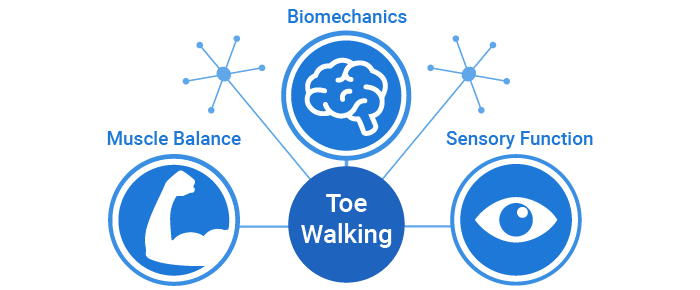Pediatric Toe Walking: Beyond Muscles And Bones!

A dynamic system is made up of multiple parts that work together to create change over time. With toe walking, we have to look at ALL the factors that contribute to walking, not just the muscles and bones!
The Sensory Side of Toe Walking
Did you know?
- Toe walking is often related to vestibular and visual dysfunction.
- There can be immediate changes in gait patterns when therapeutic eye lenses are used.
- Retained asymmetrical and symmetrical tonic neck reflexes (ATNR & STNR) are correlated with toe walking.
When pediatric therapists talk about toe walkers, you may often hear them say (with an expression of discomfort!), “I think it’s sensory.” Or maybe you even hear yourself say, “He may be a sensory toe walker.” But what does that mean and how do we know? Even more importantly, what is next??
Don’t Stop Toe Walking, Facilitate New Gait Instead
Historically, we have addressed toe walking through instruction and repetition. However, treatment is much more effective when we focus on providing the best conditions for the body to work how it’s intended. Thus, for long-term results, we should focus on facilitating a new gait pattern instead of trying to stop the toe walking.
Movement patterns develop when we have the best possible conditions. We need to provide the child with what is missing, or what is not working as well as it should. For example:
- Center of mass position
- Stability
- Quality of gait
- Arousal level
- Sensory system foundation
- Primitive reflexes
As pediatric therapists, we have to be aware of the strong influence of the sensory systems on movement and stability. We must be especially aware of the underlying sensory foundation to toe walking. To miss this is to miss the crux of the condition!
- Schaaf RC. Parasympathetic Functions in Children with Sensory Processing Disorder. Integr. Neurosci. 2010.
- Bent LR, Inglis JT & McFadyen BJ. When is Vestibular Information Important During Walking? Journal of Neurophysiology. 2004.
- Thelen E. Development of Coordinated Movement: implications for early human development. Motor Development in Children: Aspects of Coordination and Control. Boston, MA: Martinus Nijhott Publisher; 1986.
- Perry, S. Clinical Implications of a Dynamic Systems Theory. Neurology Report.1998.









